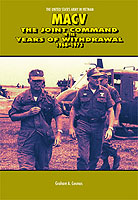U.S. Army in Vietnam

MACV: THE JOINT COMMAND IN THE YEARS OF WITHDRAWAL, 1968-1973
Graham A. Cosmas
U.S. Army in Vietnam
CMH Pub 91-7, Cloth; CMH Pub 91-7-1, Paper
2007; 487 pages, maps, illustrations, charts, bibliographical note, index
GPO S/N: 008-029-00451-8
MACV: The Joint Command in the Years of Withdrawal, 1968-1973, describes the evolution of the command during the period of U.S. disengagement from Vietnam. By late 1967 the Military Assistance Command, Vietnam (MACV), had grown from a small, temporary advisory and assistance organization into a large, permanent headquarters that directed more than half a million American soldiers, sailors, airmen, and marines in a wide range of combat and pacification operations. By that same time, however, President Lyndon B. Johnson and his principal advisers had concluded that it was necessary to begin reducing the cost in lives and money of a seemingly stalemated war. The Communist Tet offensive of January-February 1968 confirmed the president in his decision and set the United States upon a path of disengagement that President Richard M. Nixon also followed. During the period covered by this volume, MACV gradually withdrew its American troops from South Vietnam and worked to prepare Saigon's forces to defend their country by their own efforts. The MACV headquarters itself drew down toward reversion to an assistance and advisory group.
This volume tells the story of MACV's evolution as an organization and of the command's role in making and implementing American national policy in Southeast Asia during the period of U.S. disengagement from the Vietnam War. It treats both national-level decisions and military operations from the perspective of the theater joint commander.
* View this publication online.